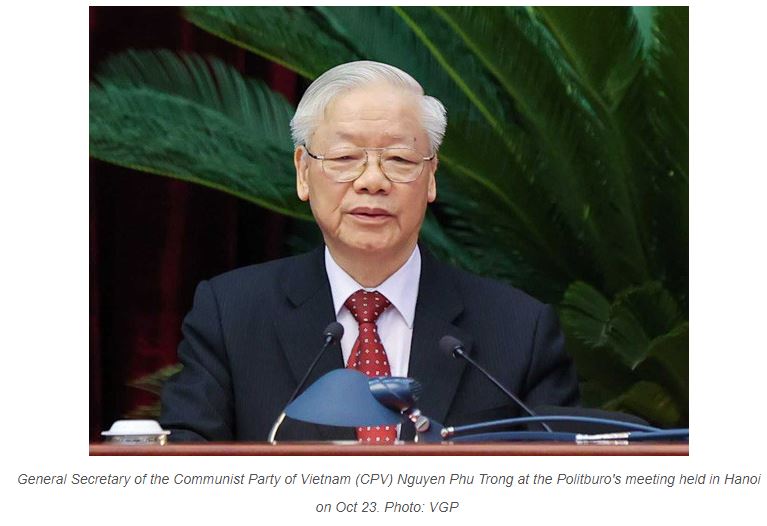Southeast region designed as economic engine of Vietnam by 2045
Southeast region, which includes the southern economic hub of Ho Chi Minh City, is planned to become the locomotive of Vietnam’s economy by 2030 with a vision to 2045, the Politburo, the most powerful body of Vietnam, agreed at a national meeting over the weekend.
The hybrid meeting, which was convened to discuss the region’s socio-economic development, marked the attendance of General Secretary of the Communist Party of Vietnam (CPV) Nguyen Phu Trong, President Nguyen Xuan Phuc, Prime Minister Pham Minh Chinh, Chairman of the National Assembly Vuong Dinh Hue, and Permanent Member of the Party Central Committee’s Secretariat Vo Van Thuong.
The event is aimed to implement Resolution No.24 of the Politburo dated October 7, 2022, on socio-economic development and defense-security in the Southeast region to 2030, with a vision to 2045.
This is the fourth Politburo meeting of its kind, following those discussing the development of the Mekong Delta, the Northern Midland and Mountainous region, and the Central Highlands.
Addressing the event, CPV General Secretary Nguyen Phu Trong asked relevant agencies to closely follow the resolution to have specific policies for the sub-region and each locality for effective implementation.
He said it’s necessary to consider discussing the implementation and having new approaches, policies, and practical action plans.

Key data
The Southeast Region, including Ho Chi Minh City and five provinces: Binh Phuoc, Binh Duong, Dong Nai, Ba Ria –Vung Tau, and Tay Ninh, is a region with a particularly important position and role in the country’s socioeconomic development, national defense, security, and foreign affairs.
The Southeast region, which borders Cambodia to the north and west, is characterized by numerous large rivers, including the Dong Nai and Saigon rivers, and primarily flat topography with only a few minor hills. Ho Chi Minh City is the hub connecting the whole region by waterways and well-invested expressway networks.
With impressive growth fueled by a massive energy industry and a thriving manufacturing sector, the region contributes 32% of the country’s GDP and 44.7% of the total state revenues. It attracts 41% of foreign direct investment (FDI) in Vietnam and is home to the highest number of businesses. The region’s urbanization rate is 67%.
In 2020, the region’s GRDP increased 4.9 times compared to 2005 and 2.6 times higher than in 2010, exceeding the set target. Its per capita income in 2020 was the highest among regions, at VND6 million (US$260)/person/month compared to VND2.7 million in the northern midland and mountainous area.
Under Resolution 24, by 2030, the Mekong delta’s Southeast Region will become a dynamic development area with a high economic growth rate, becoming the most prominent growth engine of Vietnam, which is home to a science-technology and innovation center, high-tech industry, logistics hub, and international financial center.
The region will lead in digital transformation, smart urban networks, transport, and trading systems connecting the whole area, between regions and the world, while holding the top position in education and healthcare.
By 2045, it is designed to be a developed region with a solid and modern economic structure, ensuring the harmonious combination of socio-economic with culture and environmental protection. It is expected to be among the leading Southeast Asian regions in healthcare and education.
To make the goal possible, the region is tasked with improving the regulatory framework and boosting inter-regional connectivity while developing science, technology, and infrastructure.
Measures
Dr. Do Thien Anh Tuan from Fulbright School of Public Policy and Management, Fulbright University Vietnam, said Resolution 24 demonstrated how important is the Southeast Region in the view of the Vietnamese leadership.
Nevertheless, it requires breakthroughs to implement the resolution, Tuan said, noting that realizing the plans and policies becomes crucial.
Tuoi Tre Newspaper quoted him as saying that it should be specific when implementing strategies and there should be regional apparatus that is powerful enough to coordinate and connect the whole region.
For that reason, government agencies must follow the resolution closely instead of existing regulations to ensure smooth implementation.
Nguyen Hoang Bao, University of Economics Ho Chi Minh City, said it’s necessary to have specific short-term and long-term measures and resources for the implementation, coupled with mobilizing different resources amid limited state budgets.
In addition, it is necessary to define the power and responsibilities of the regional heads clearly.
Associate Prof. Vu Anh Tuan, Vietnamese-German University, emphasized mechanisms and policies in mobilizing resources for infrastructure projects, highlighting the role of the National Assembly, the Government, and localities in the issue. Above all, he stressed the need for building and connecting infrastructure in Ho Chi Minh City and nearby localities.
Source: Hanoi Times


 Thailand
Thailand




